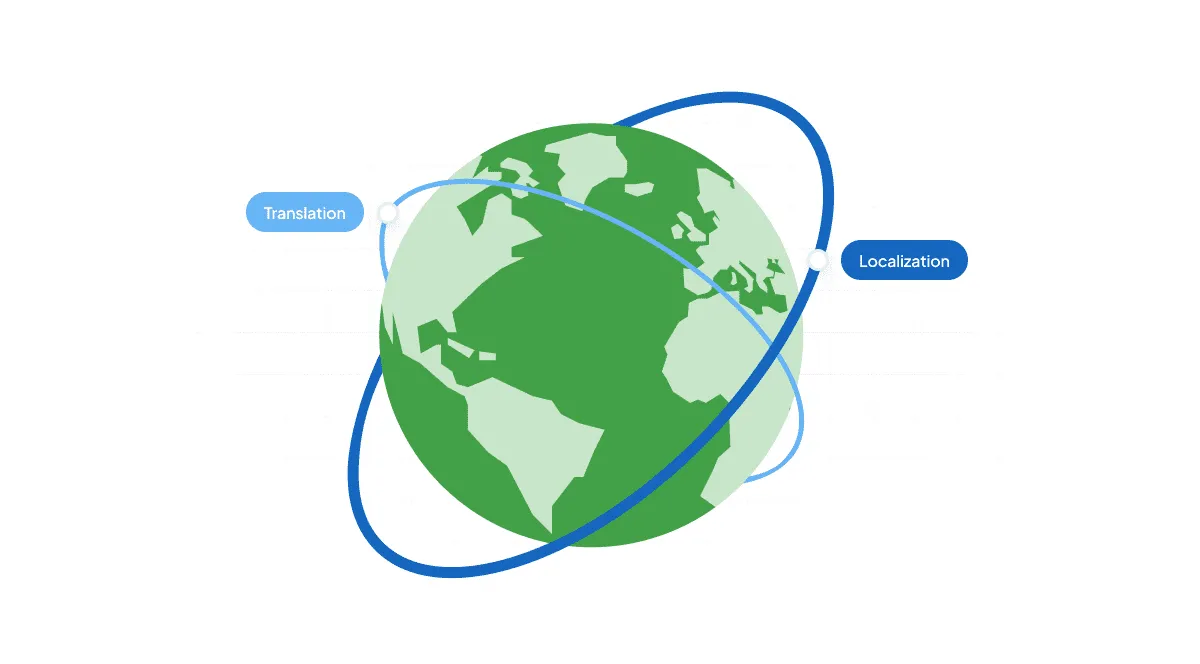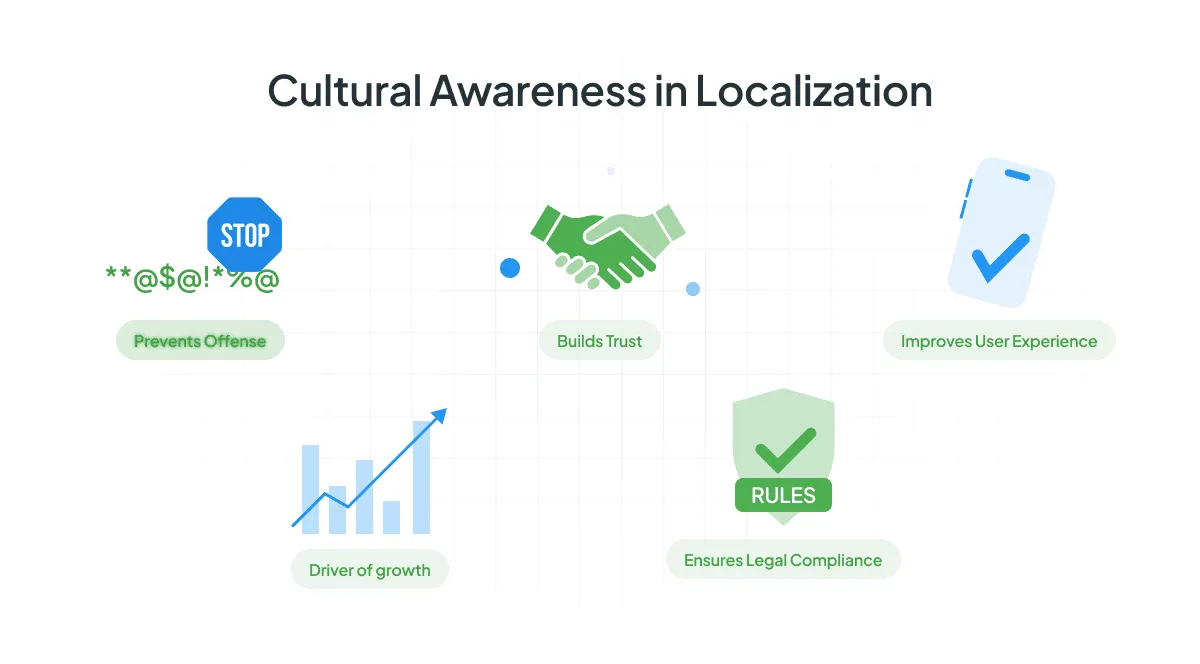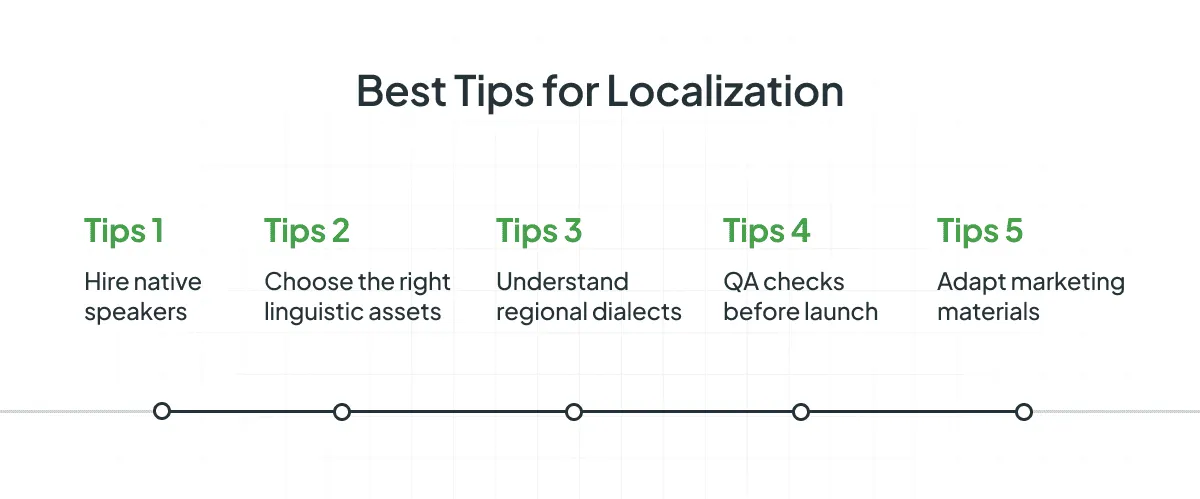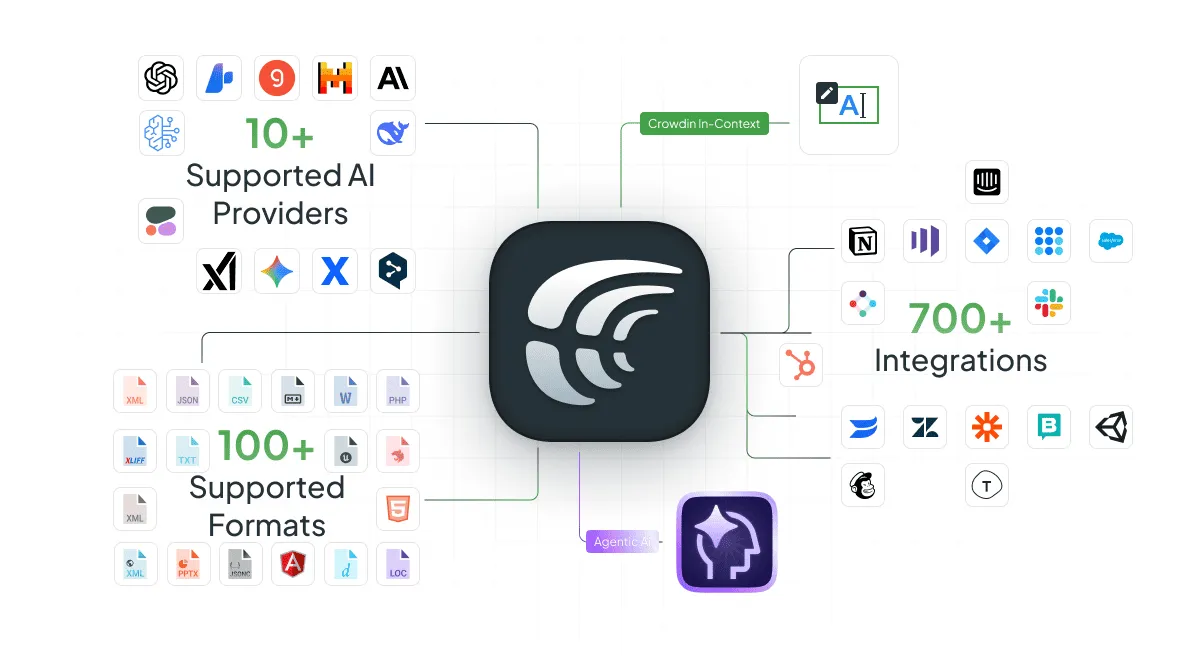Localization is the process of making a product or service fit the cultural, linguistic, and other needs of a specific target market. It’s often abbreviated as l10n, with the 10 representing the letters between the ‘l’ and the ‘n’ in the full word.
Localization is an essential part of growing a global business to successfully set up in international markets. L10n efforts of the companies are focused on cultural adaptation of the business processes in order to connect with customers in different parts of the world, improving customer satisfaction and loyalty, and, as a result, generating more revenue.
In this blog post, we will explore the benefits of localization, the difference between language translation and localization, how localization works, and how to create an effective localization strategy.
Why Is Localization Important for Global Growth?

Localization lets businesses reach people of multiple cultures, get local customers more involved, and get closer to their audience by adapting the product or service to the local culture. Localization project includes a range of vital procedures:
- translating the text into different languages
- adapting images, graphics, and layout based on the local preferences of the specific regions and the direction of reading (right to left, left to right, up and down)
- coding to adjust for local currency
- adaptive measures to time and date formats
- adjustment to other cultural differences
- reviewing legal requirements for operations in the local markets
Let’s say there is a business that manufactures shoes and wants to take its business operations to Japan. The first barrier is the primary language of the country. If the company only showcases its products on its English website, any potential to develop a successful business will be lost.
By localizing its website’s layout, product descriptions, translating pages into the Japanese language, providing prices in local currencies, and tailoring the content to local values, the company is more likely to connect with customers and sell its products.
Localization is also essential for maintaining consistency of the brand across different markets. By adapting content and the way they approach customers for each market, businesses can be sure that their audience receives a consistent and meaningful message that is tailored to their language and cultural preferences.
How Is Localization Different from Translation?
Localization and translation are often used interchangeably. However, they are two distinct concepts where one is a part of the other.

Translation is the process of changing a source language into another language. It can be done using the knowledge the translator has or vocabulary, but more and more often, rapidly evolving translation technology is used.
Localization, on the other hand, is a broader term that makes use of the translated content to fit the needs of a specific market. Localization takes cultural differences, idioms, images, text length, measurement units, and other local factors into account when determining the meaning, tone, and context of the translated content. Localization is a part of the internationalization process.
In other words, localization is more than just translating the content; it also changes the whole user experience to fit the needs of different locales.
Key Considerations for Localization Project
Localization is not something you can do over the weekend. It is a multichannel process that requires professional localization managers with deep knowledge of global marketing and particularly the region you want to expand to. To ensure your localization efforts do not go to waste, there are a few key things you need to keep in mind:
- Target Audience: It’s essential to understand the target audience’s language, culture, and preferences to adapt the content appropriately. The process involves conducting market research, gathering customer feedback, and analyzing the competitive landscape. You can create separate user personas for new markets to understand their specific needs and adapt your approach accordingly.
- Linguistic and Cultural Differences: Localization involves much more than just translating words from one language to another. To be effective, content must be adapted using local idioms, phrasing, tone, and cultural references to resonate with the target audience. Keep in mind that even in the places where people use the same language, words can have different meanings. That’s why a strong localization team is a must. And don’t forget that images and videos should also be localized.
- Availability of Local Resources and Expertise: Finding a reliable local partner with in-depth knowledge of the target market and a local team can help large-scale projects ensure high-quality localization. If you’re a small project, you can consider talking to your local customers, colleagues, or local translation and localization experts.
- Clear Goals and Objectives: Establishing clear goals and objectives is essential for successful localization. This can include creating a localization roadmap, setting realistic timelines, and identifying the key performance indicators (KPIs) that will measure the success of the project. You need to understand what your long-term goals are. Your priority might be to enter a new market, increase brand awareness, improve activation and retention rates, or something else.
Importance of Cultural Awareness in Localization
Cultural awareness is an essential aspect of localization. Businesses should aim to understand the customs, beliefs, and values of the target audience to adapt the content accordingly.

Failure to respect cultural differences can negatively impact the customer experience, damage brand reputation, and result in lost business opportunities. By demonstrating cultural awareness and sensitivity, businesses can build trust and credibility with their target audience, improve their brand reputation, and create strong relationships with their customers.
That is why having a local partner, doing research, or hiring a local team is something worth considering for your main markets.
How the Localization Process Works
For starters, you can choose one aspect of your business to localize. It can be a website, app, blog, marketing & sales campaigns, help center, or any other customer-facing content. Your project can expand pretty quickly, so you should create processes that will allow you to scale.
Let’s go over some basics of localization for different types of content.
Localization of the Website
Localizing a website involves translating its text, images, and multimedia files into the native language of your target audience. In addition to translating the website, localization may also involve changing the layout and design of the website to fit the local culture. This could include making changes to the colors, fonts, and pictures to create a more appealing look to the local audience.
Software Localization
Software localization is the process of changing a software product so that it fits the language, cultural, and technical needs of a specific market. The first step is to figure out who the target market is and what languages, regional differences, and cultural differences may affect the product.
Once the target market is determined, the software developers start working on translating the software interface, help documentation, and user manuals into the target language. Many apps and websites support multiple languages, and users can choose the option they prefer.
In addition to translating the website, software localization may also involve changing the product to meet local technical standards, such as:
- Date and time format
- Local currency
- Measurement system
Other localization considerations may include user interface design, colors, and images, since some graphics can be offensive or culturally inappropriate in the target market.
User Manuals and Help Documentation
Product documentation localization is the process of adapting product manuals, user guides, and other technical documents to meet the language, cultural, and technical needs of a specific market. The process starts with understanding the target market’s language and technical requirements.
Documentation localization typically involves translating the technical content into the target language as well as changing the technical content to meet local technical standards, such as date and time formats, measurement systems, and legal rules. Other things to think about when localizing the document include changing the format, layout, and illustrations to fit the preferences and most common formats of the local audience.
Customer Support and Service
The customer support team requires localized communication to ensure not only customer satisfaction, but also to provide a channel for communication where both parties understand each other. Proving a localized product is not enough; the customers should be able to receive necessary help without straining.
One of the best ways to localise your communication is to have dedicated software like Crowdin. It can help businesses translate emails, phone scripts, and online chat messages into different languages, ensuring that customers can communicate with support teams in their native language.
Marketing Localization
Marketing localization means changing marketing materials and strategy so that they meet the language, cultural, and technical needs of a specific market. The process starts with understanding the target market’s preferences, like language, cultural nuances, and advertising regulations.
Marketing localization may also involve translating advertising copy, taglines, and slogans into the target language and tailoring the marketing materials to the cultural preferences of the target audience. The process includes manipulating local celebrities, symbols, or images that the people know and care about. Project managers should also adjust the marketing message to better align with the cultural values and beliefs of the target market.
Best Practices for Localization
When it comes to localization, there are several best practices that have shown excellent results. Thus, to ensure a successful transition into global markets, the business needs to follow this practical advice:

- Hire native speakers: When localizing content for different countries, it’s crucial to hire professional native translators who understand the language and cultural nuances of the target audience. This will ensure that your content is well-written, accurate, and resonates with people.
- Choose the right linguistic assets: Choosing a localization platform like Crowdin that allows your team to process multiple languages at once and manage text strings efficiently can help streamline the entire localization process.
- Understand regional dialects: Knowing regional dialects within each language is essential for ensuring accuracy and understanding between different cultures and regions. Localization tools can help identify regional differences in language and provide suggestions on how best to localize content for various markets.
- Review your localized content before launch: Quality software provides various features to help you effortlessly access the content and check it for any errors. With Crowdin, you review your website using in-context to make sure everything looks good before going live. For mobile apps, you can use the Real-Time Preview feature of Crowdin’s mobile SDK for Android and iOS apps. To be sure that your content is error-free, try running translation QA checks to reduce typos and other errors.
- Adapt marketing materials: When localizing marketing materials such as websites, emails, or ads, it’s essential to adapt them for each market according to local preferences, values, standards, regulations, etc., rather than simply translating them word-for-word from one language into another. For example, when translating an email, it’s important to see the whole file instead of translating scattered sentences without context.
By following these best practices when localizing content for global markets, businesses can ensure their messaging will resonate with the target audiences.
The Importance of Localization Management Software
A localization management software is a tool that enables businesses to simplify the localization process by automating tasks, centralizing communication, and managing translation workflows. This platform allows businesses to easily upload and manage content, collaborate with translators and other stakeholders, and track the progress of their localization projects in real-time.
By using a localization platform, businesses can save time, reduce costs, and improve the quality of their localized content. The platform enables efficient management of translation memory and glossaries, ensuring consistent and accurate translations across all their content.
Why Choose Crowdin as Your Localization Management Tool?
Crowdin is a cloud-based localization platform that helps businesses manage translations and other parts of the localization process more efficiently. With its user-friendly interface and wide range of localization features, Crowdin has become a popular choice for businesses of all sizes that want to expand their reach and communicate with their global customers.

Automation Features
One of the main benefits of using Crowdin is its automation features. The platform allows you to automate many of the time-consuming tasks involved in the localization process, such as:
- translation memory management
- glossary management
- file versioning
This not only saves time but also ensures consistency across all localized content.
Collaboration Tools
Another benefit of Crowdin is its collaboration capabilities. The platform allows businesses to work with multiple translators and stakeholders simultaneously, making it easy to manage complex translation projects. Its built-in communication tools, including comments and notifications, also help ensure everyone is on the same page and up-to-date on project progress.
Software Integrations
Crowdin offers over 700 integrations with leading content management systems, development tools, and other platforms. The platform also supports over 100 file formats, so you can localize almost any type of content.
AI Tools
AI is essential for fast and efficient localization. Crowdin makes it easy to use powerful technologies while keeping a human in charge.
The platform supports all the top AI providers, including OpenAI, Google Gemini, Microsoft Azure OpenAI, and Anthropic, so you can pick what works best for you. You can also use your own API keys for more control and data privacy.
With Crowdin’s AI features, you can:
- Add context using things like screenshots and string identifiers.
- Generate first drafts of translations.
- Automate quality checks.
- Summarize and rephrase text.
- Change the tone and style.
- Make sure translations fit your user interface by limiting characters.
If you are looking for a localization platform that is easy to use, offers automation and collaboration features, and integrates with your existing workflow, Crowdin is the software you need. With a robust feature set, flexibility, and scalability, it is an ideal solution for businesses looking to expand their reach and connect with customers around the world.
Creating a Localization Strategy
As we already know, localization is essential for the growth of a global business. It enables companies to enter new markets, connect with local customers, and increase revenue.
A localization strategy can improve customer satisfaction and loyalty, increase sales rates, and give your company an advantage over the competitors. It can help businesses change their products or services to meet the needs of customers in their area and stand out from other localized products.

To create an effective localization strategy, businesses need to:
- Define goals: Clearly state what you want to achieve with localization.
- Know your audience: Research the cultural and linguistic needs of your target markets.
- Plan the process: Choose the right content, tools, and team.
- Ensure quality: Implement a review process to maintain accuracy and brand consistency.
A successful localization strategy has a clearly established set of goals with a focus on user experience and quality. It implies a deeper understanding of local customs and cultural norms.
Conclusion
In summary, localization is a critical component of a business’s global strategy. By adapting content, services, and products to meet the linguistic and cultural preferences of different markets, businesses can. In summary, localization is an essential component of any business’s global strategy. By adapting content, services, and products to meet the linguistic and cultural preferences of different markets, companies can engage with a broader audience, build brand loyalty, and increase revenue.
The demand for localization services is skyrocketing as businesses look to expand their reach and cater to a global audience. You need to automate content updates, boost team collaboration, and reach new markets faster to stay ahead of the competitors and improve your revenue rates.
Localize your product with Crowdin
FAQ
What is localization?
Localization is the process of adapting a specific product or service for different international markets.
What is an example of localization?
There are several famous examples of localisation, including Nestle selling different Kitkat flavours based on the country, McDonald’s adapting their menus, and common streaming, gaming, and selling platforms supporting multiple languages.
Why is localization important?
Localization allows your business to connect with people of different cultures by not only relating to them but fitting into their expectations in order to increase sales and gain a competitive advantage.
What are the most essential parts of successful localization?
To successfully localize your business, you need a localization strategy, a strong localization team, and a robust localization management tool.
Why choose Crowdin as a translation management tool?
Crowdin is a robust localization software that helps you manage all localization processes with higher efficiency using a comprehensive list of automation features, collaboration tools, and integrations with other valuable software.
Julia Herasymchuk
Julia Herasymchuk is the Content Manager with over 8 years of experience. She is a skilled professional at crafting compelling, well-researched content that resonates with audiences.
